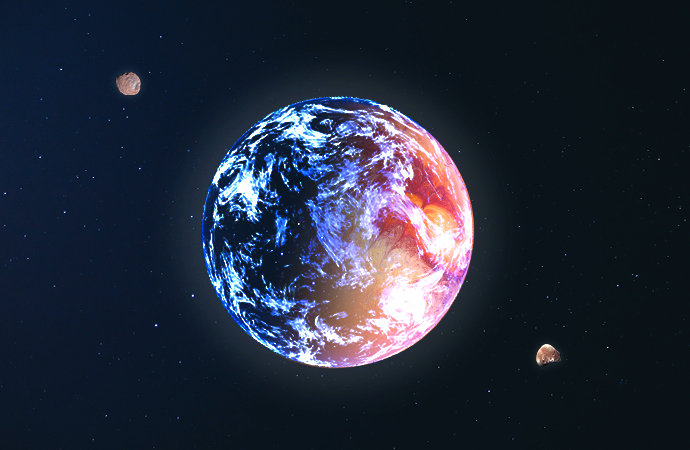Today, Mars is a cold desert planet, more closely resembling Arrakis in the sci-fi story Dune than to the Earth. But how was it billions of years ago?
In the Beginning, 4.5 billion years ago, it was blazing hot and ferocious on Mars. Its crust was forming, lava ran, asteroids hit its surface, and outgassing dominated the scenery. Gradually that vigor gave way to a calmer, colder planet. Its surface developed two faces, plains spread across the northern hemisphere, while colossal mountains accommodated in the southern hemisphere. Geologists call this “Mars dichotomy.”
In the Noachian era, 4.1 – 3.7 billion years ago, the water vapor emanated by the volcanoes condensed and rained until oceans, rivers, and lakes formed. About half of the planet became covered with liquid water. But for liquid water not to evaporate into outer space before those oceans and rivers formed, a thick atmosphere must have been protecting it. Studies estimate that the atmospheric pressure on Mars was probably half of the Earth’s today. And If there were significant amounts of stagnant water, undoubtedly the sky hosted clouds. That cozy environment was shielded by a planetary magnetic field.
With those conditions on our neighboring planet resembling the Earth, the rise of life is easy to picture. Until now, no evidence that Mars once hosted life has been found, but the search for its traces continues tirelessly. Such a find would change our view of the universe and ourselves forever.
In the Hesperian era, 3.7 – 2.9 billion years ago, many volcanoes became extinct and the surface cooled down further. Its magnetic field turned off, leaving the outer part of the atmosphere unprotected. The planet’s gravity was not strong enough to sustain the air, and atoms escaping into space accelerated. With a thinner atmosphere, the water evaporated, turning Mars into the arid red planet we see today.
But how do we know that history?
Science has been a fabulous tool to reconstruct our planet’s past. Paleontologists, archeologists, and geologists have uncovered amazing extinct creatures like the dinosaurs, ancient civilizations such as the Maya, and supercontinents like Pangea. And it is no different on other planets. We have been sending orbiters and robots to Mars because the more we explore it, the more we learn about its history.
Evidence that tells a story of water
In rocky planets, large portions of liquid water leave footprints on the surface after it dries out. Comparing the geology and chemistry on Mars with that of the Earth and looking at the history of how water created sediments and ice caps help propose models on oceans, rivers, and lakes.
The presence of mudstones in the northern hemisphere indicates that large portions of liquid water flooded it. Those lakes and oceans were probably contracting and enlarging for billions of years.
The Oceans
Studies estimate that oceans in the north would have occupied about two-thirds of the hemisphere, with an average depth of 140 meters and trenches reaching 1.6 kilometers. That is about half of the volume of the Atlantic ocean on Earth.
In 2018, researchers at NASA Goddard Space Flight Center found an abnormally large proportion of deuterium in the ice caps. A higher than expected ratio of deuterium vs. water indicates that a lot of water has been evaporated. The reason is that deuterium is heavier than water and tends to remain deposited. This discovery added evidence to the presence of significant ancient—and probably current—water reservoirs on Mars and helped unravel its disappearance mechanism.
The following video is an artist’s impression showing how Mars lost most of its surface water over the past four billion years. Credit: European Southern Observatory.
The rivers
In an article published last year, Francesco Salese from Utrecht University and collaborators studied the layered sedimentary rocks in the Northern Rim of Hellas Basin using the High-Resolution Imaging Science Experiment-HiRISE. They examined the basin cliffs with unprecedented detail, finding channels and bar form packages. Their observations led them to conclude that those scratches were sculpted by mighty rivers that flowed down those valleys more than 3.7 billion years ago—roughly the time when life arose on Earth.
Habitability and the meaning of liquid water on Mars
An essential habitable condition on a planet is the presence of liquid water. Still, the meaning of liquid water changes from one planet to another.
In 2015 NASA-Reconnaissance Mars orbiter found that currently, during warm seasons, liquid water flows in multiple places such as Acidalia Planitia, Palikir Crater, and Valles Marineris. It was an exciting moment in the history of interplanetary exploration.
However, the water was found in the form of hydrated salts, specifically perchlorate-brine. On Mars, pure liquid water is volatile due to the thin atmosphere. While it turns into ice at 0 °C, like on Earth, it boils only at 10 °C on Mars. But the perchlorate-brine is a stable liquid in a wide range of temperatures (between -70 °C and 24 °C). How do these salts get the liquid water? How is the hydrological cycle on Mars? It is still unknown.
Molecules of life
The idea of the possible presence of microbial life during the Noachian era—when water was abundant on Mars—is very appealing. Water is a necessary condition of life, but it is not sufficient. Finding biosignatures (specific chemistry or patterns that typically require biological processes) or biomarkers (fossilized tissue or cells) is a requirement to seriously address the hypothesis of past or present life on another planet.
Since 2012, Curiosity has been exploring Mount Sharp and the Gale crater—which was home to a lake 3.5 billion years ago. In 2018, the rover found organic molecules in the crater’s sediments, including substances typically associated with biological processes on Earth. The carbon concentration was about ten milligrams out of one kilogram, a pinch of salt in an Olympic swimming pool. However, those rocks should have preserved many more molecules of life due to the planet’s lack of tectonic activity. The question is if there was life on Mars, why did Curiosity not find more traces?
According to researchers at the Exobiology Branch at NASA Ames Research Center infiltrations of super-salty waters or brines in the Gale crater may have altered the composition of the minerals. Brines have the power to erode organic molecules’ memory, making the search for past life harder.
In the same year, Curiosity also detected seasonal gas methane plumes in the atmosphere, a finding corroborated by the NASA-Mars Express orbiter. That means large quantities of methane peak in summer and drop in winter every Martian year. On Earth, 90% of the atmospheric methane comes from living organisms’ emissions: from microbes to cows. However, methane can also have non-biological origins.
ESA’s ExoMars Trace Gas Orbiter has been hunting methane in the high Martian atmosphere without success, which has puzzled many planetary researchers. Christopher Webster and collaborators at NASA recently reported a significant difference between day and night concentrations of the atmospheric methane detected by Curiosity.
Cold temperatures during the night could be responsible for the gas being concentrated low in the crater, where Curiosity can measure them, escaping during the day. However, the heat during the day dilutes it to undetectable amounts at high altitudes.
The volcanos
Volcanoes transform the composition and structure of rocks and minerals. They cause great changes to the planet’s interior, surface, and atmosphere that are impossible to hide.
Billions of years ago, Mars was a hot, geologically active planet with plenty of volcanic eruptions. Direct evidence has been observed since the Mariner Missions in the ’70s. To date, seventy-five mountains have been identified as extinct volcanoes, although it is unclear whether they were explosive or effusive.
Several places are candidates to have hosted explosive volcanoes. One of them is the Arabia Terra region. Patrick Whelley from the University of Maryland and colleges found a collection of craters with scalloped edges could have been produced by superexplosive volcanic eruptions. The shape of these calderas is consistent with models of explosive volcanoes. However, the crucial evidence is in the minerals found in seven places in the region.
Using photos of cliffs faces and crater walls taken by NASA Reconnaissance orbiter, they found unaltered minerals, including olivine and pyroxene. These igneous rocks typically form during volcanic eruptions. Whelley and his team also found hydrated sulfates, phyllosilicates (with Magnesium and Iron), or opals, which can be interpreted as ash remains.
More recently, researchers at the Lunar and Planetary Laboratory, University of Arizona, used data supplied by the Insight robot to study the nature of the marsquakes. The results point out that some volcanoes on Elysium planitia could still be active.
The sky
The thicker, cozy atmosphere that once warmed the red planet turned into a skinny cold layer we see today. Ions of oxygen, carbon dioxide, nitrogen, and argon have been escaping Mars for billions of years. Mars’ low gravity—one-third of the Earth’s—could not hold those amounts of air. However, low gravity is not the only factor. After the planet lost its magnetic field, the atoms in the high atmosphere were left unprotected from the harsh solar wind. For almost two decades, ESA’s Mars Express orbiter has observed how electrically charged molecules such as oxygen and carbon dioxide ions escape into space.
Robin Ramstad of the Swedish Institute of Space Physics and colleagues studied the orbiter’s data finding the ultraviolet radiation guilty. After the sun wind removes ions from the atmosphere, the Sun UV radiation produces more ions, which are then removed by the solar wind.
How do scientists estimate how thick Mars’ atmosphere was? Atoms usually come in a mixture of isotopes, elements with the same number of protons but different numbers of neutrons. Since today’s Mars atmosphere is 96% carbon dioxide, investigating the proportion of oxygen isotopes in the air makes sense. Oxygen can come in a mixture of O16, the most common and lighter isotope, and O18, a heavier isotope. A NASA funded study discovered that Mars’ atmosphere has been enriched with the heavier isotope O18, relative to the Earth, which indicates that the lighter (O16) has been escaping into outer space.
Another way to investigate Mars’ atmosphere depletion is by looking at its moons. Many atoms that have been escaping ended up smashed on the moons’ surfaces. Researchers at the Space Sciences Laboratory, University of California at Berkeley studied Phobos for more than four years. They found an asymmetry in the element’s content—characteristic of the Martian atmosphere—between the near and the far side of the moon by a factor of two. In their article published in Nature Geosciences, they wrote: “oxygen, carbon, nitrogen and argon atoms are implanted and may be preserved inside the uppermost hundreds of nanometres of Phobos’s nearside regolith grains.”
Many mysteries about the Red Planet remain unraveled. Most of the water escaped, but scientists believe there is still a considerable amount of water underground. Was Mars home to some form of life? Up to now, no solid evidence has been found. The new Mars rover inhabitant Perseverance carries the dream of finding signs at least of past microorganisms.
Today we know more about Mars than Europeans knew about the American continent five hundred years ago. And soon, we will be ready to colonize it. How? That is a story for another time.
References
Bristow et al. (2021). Brine-driven destruction of clay minerals in Gale crater, Mars. Science 373(6551), 198–204.
Nénon, Q., Poppe, A.R., Rahmati, A., et al. (2021). Implantation of Martian atmospheric ions within the regolith of Phobos. Nat. Geosci. 14, 61–66. https://doi.org/10.1038/s41561-020-00682-0
NASA’s Curiosity Rover Finds Patches of Rock Record Erased, Revealing Clues. (2021, July 8). JPL. https://www.jpl.nasa.gov/news/nasas-curiosity-rover-finds-patches-of-rock-record-erased-revealing-clues
Whelley, P., Matiella Novak, A., Richardson, J., Bleacher, J., Mach, K., & Smith, R. N. (2021, August). Stratigraphic Evidence for Early Martian Explosive Volcanism in Arabia Terra. Geophysical Research Letters. https://doi.org/10.1029/2021gl094109
Horvath, D. G., Moitra, P., Hamilton, C. W., Craddock, R. A., & Andrews-Hanna, J. C. (2021). Evidence for geologically recent explosive volcanism in Elysium Planitia, Mars. Icarus, 365, 114499. https://doi.org/10.1016/j.icarus.2021.114499
Lauro, S.E., Pettinelli, E., Caprarelli, G. et al. (2021). Multiple subglacial water bodies below the south pole of Mars unveiled by new MARSIS data. Nat Astron 5, 63–70 https://doi.org/10.1038/s41550-020-1200-6
Timothy A. Livengood, Theodor Kostiuk, Tilak Hewagama, Ramsey L. Smith, Kelly E. Fast, John N. Annen, Juan D. Delgado. (2020). Evidence for diurnally varying enrichment of heavy oxygen in Mars atmosphere, Icarus 335(113387). ISSN 0019-1035, https://doi.org/10.1016/j.icarus.2019.113387
Salese, F., McMahon, W.J., Balme, M.R. et al. (2020). Sustained fluvial deposition recorded in Mars’ Noachian stratigraphic record. Nat Commun 11, 2067 https://doi.org/10.1038/s41467-020-15622-0
Villanueva, G. L., et al. (2018). Strong water isotopic anomalies in the martian atmosphere: Probing current and ancient reservoirs. Science, 348(6231). https://www.science.org/doi/10.1126/science.aaa3630
Tokyo Institute of Technology. (2017, October 2). Meteorite tells us that Mars had a dense atmosphere 4 billion years ago.” ScienceDaily. ScienceDaily, www.sciencedaily.com/releases/2017/10/171002114214.htm
Ramstad, R., S. Barabash,Y. Futaana, H. Nilsson, and M. Holmström. (2017). Global Mars-solar wind coupling and ion escape, J. Geophys. Res. Space Physics, 122, 8051–8062, doi:10.1002/2017JA024306.
McEwen, A., Dundas, C., Mattson, S. et al. (2014). Recurring slope lineae in equatorial regions of Mars. Nature Geosciences 7, 53–58.
Feature illustration: Dana Dumea.





